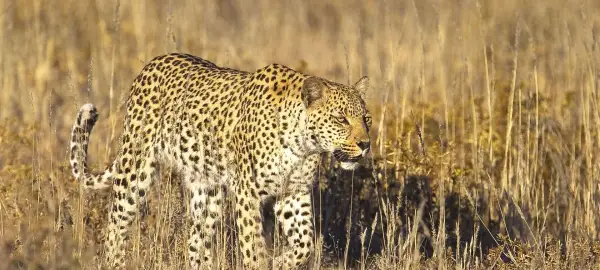- Overview
- Info & Inclusions
- Itinerary
- Map & Hotels
- Photos
- Dates & Prices
- Max Group Size 18
- Apricot dunes at sunrise
- Kaleidoscope of cultures
- Rugged Skeleton Coast
- Etosha: Africa's undiscovered wildlife gem
- The Okavango inland delta
- Thundering Victoria Falls
- Singles friendly (view options for single travellers)
Technicolour landscapes of pastel-basted rock formations, waves of taupe grasses and orange-pink clouds mark our route as we journey to one of the largest conservation areas on the planet in Namibia, where we have the chance to see kudus, springboks and black eagles set against some of the most expansive and dramatically rugged scenery in the world.
Alone for miles and dwarfed by apricot-coloured sand dunes, we experience one of the high points of our tour, which can bring with it a profound, almost spiritual, effect on the senses.
Through German colonial towns with eclectic mixes of Bavarian and Bohemian architecture, we travel through unexpected and surreal scenery, and make our way to the Skeleton Coast, where we can take to the skies for an aerial view of seas of golden dunes, shipwrecks and perhaps the famous Damara desert-dwelling elephants.
We see geological oddities, examine some of Africa's finest prehistoric rock art, paintings and engravings that date from over 5,000 years ago, and gaze at teeming wildlife at perhaps the best-kept secret of African safari destinations.
As we cross into Botswana, the marshlands of the Okavango Delta serve as the ideal location to view hippos and crocodiles in their natural habitat and thereafter it's on to what is arguably the most spectacularly beautiful game park in Southern Africa; Chobe National Park.
The final days of our adventure deep in the heart of Africa are well-spent watching out for zebra, buffalo, wildebeest, antelope and, of course, elephants, cheetahs and lions, while we explore traditional and colonial villages, learn about the lives of indigenous peoples and take in the splendour of one of the natural world's most incredible sights in Zimbabwe; Victoria Falls.
- Breakfast daily and most dinners
- Most meals in Botswana.
- All accommodation, transport, sightseeing and entrance fees for sites noted as 'visited' in the detailed itinerary.
- Gratuities for drivers, local guides, restaurant staff, porters in Namibia and Chobe ONLY.
- Airport transfers for land & air customers arriving / departing on tour dates.
- International airfare to/from the tour.
- Tour Leader gratuities, some lunches, 2 dinners, drinks, personal items (phone, laundry, etc)
- International (if applicable) and domestic air taxes
- Early/late arrivals/departures for Land Only customers.
- We do NOT include tipping for lodge staff and guides in Victoria Falls & Okavango.
- Optional trip cancellation insurance.
- Our post-reservation trip notes offer further guidance on tipping, shopping and not included meals.
- Seasonality and Weather:
November to April:
The ‘rainy’ season is during the summer months, from November to April. The weather tends to be hot and humid with dramatic afternoon thunderstorms. However, the downpours are short and heavy, so it's unlikely that the rain will disrupt your travel plans -- meaning that you don't have to worry about when to go to Namibia because even the rainy season is a great time to visit. March can also be a good time to visit Namibia's Etosha National Park; following the birthing season in January and February, you will be able to see young animals taking their first steps in the wild. That said, the lush vegetation seen in March to May can make game viewing more challenging. For our March/April trip, we may need to adjust our activities and modes of travel in the Okavanga depending on water levels at this time of year.
June to October:
The ‘dry’ season takes place during the winter months from May to October and the weather is typically warm and sunny, albeit with very cold nights. These months are considered to be the best time to go to Namibia, as you can enjoy uninterrupted blue skies and plenty of sunshine, except along the coast where there is often a fog. The daytime temperatures during these months are moderate, however it can get very cold in the evenings.
In terms of wildlife, the dry winter months (June-August) are ideal for game viewing in Etosha National Park because the vegetation is sparse and water sources dry out. - Transport and Travel Conditions:
Land transport in Namibia is via specialized 4x4 safari vehicles, equipped with air-conditioning and fridges for drinks and snacks.
All vehicles are equipped with:
• Roof pop-tops for better photography and game viewing vantage points
• Air-conditioning
• Onboard fridge/freezers and plenty of water.
• Personal library, which includes a series of guidebooks, maps, stationery and checklists.
• 220-volt electrical charging point, to charge electrical devices whilst travelling.
• Guaranteed window seat on every safari.
• VHF inter-vehicle radios that allow multi vehicle groups to communicate with each other while ‘on the road’
Namibia is a huge, sparsely-populated country with great distances between facilities. We stop for breaks as often as possible, but you must be prepared for some long days and some early starts.
BOTSWANA: We access remote lodges using chartered light aircraft; our transport in Botswana will similar to that described above for Namibia for our game drives in Chobe and road journeys.
Am I suitable for this tour? Please refer to our self-assessment form - Activity Level: 1
No particular physical activity is involved other than town/city walks and short walks to dinners and sites of interest, some of which are large.
To learn more about the Activity levels, please visit our tour styles page. - Accommodation:
NAMIBIA: Well-located, air-conditioned, 3&4-star hotels with en suite toilet and bath throughout (maybe shower only). Some hotels have hairdryers, irons, and outdoor swimming pools. Porter service is available throughout (see 'Inclusions'). Single rooms are limited and likely smaller than twins. There is no camping in Namibia.
BOTSWANA: Lodges in Okavango, Chobe and Vic Falls are very comfortable and with all modern
conveniences.
Please click on the "Map & Hotels" tab for details pertain g o our accommodation typically used on this tour. - Staff and Support:
Local Tour Leader/s throughout Namibia.
Your Namibia leader will not accompany to Victoria Falls & Botswana where your experience will be managed by our trusted local representatives and lodge staff. - Group Size:
Maximum 18 plus Tour Leader
- Day 1:Arrival in NamibiaArrival in Windhoek, the capital of Namibia. Founded in 1840 as a hot springs settlement, Windhoek grew into a colonial administrative centre and today serves as the country's political and economic heart. The city's architecture reflects its German colonial past, with Lutheran churches and turn-of-the-century buildings standing alongside modern office blocks.
This evening we meet our Namibia-based Tour Leader and fellow travellers for a welcome dinner.
NOTE: Due to space availability and other considerations, our Namibia itinerary may run in reverse order (Windhoek to Windhoek).
Overnight in Windhoek.
Included Meal(s): Dinner, if required - Day 2:Windhoek - Namib-Naukluft National ParkAfter breakfast we leave the interior plateau and head southwest through the Gamsberg Pass toward the Namib Desert. The landscape shifts dramatically as we descend — from grasslands to rock formations and eventually to the dunes that define this ancient desert. The Gamsberg Pass itself offers sweeping views across multiple climate zones, a reminder of the elevation we're losing as we drop from the central highlands toward the coast.
In the Nama language, Namib means "vast" — an apt description for this expanse of sand that stretches along Namibia's entire 1,500-kilometre (930-mile) coastline. The Namib is considered one of the world's oldest deserts, with arid or semi-arid conditions persisting for at least 55 million years. The Sossusvlei dunes, at 300 metres (1,000 feet), rank among the world's highest — considerably taller than their nearest rivals in Arabia.
Animals, insects, and plants have adapted remarkably to survive here. The Namib beetle collects moisture by standing on its head in the early morning fog, allowing water droplets to run down its back to its mouth. The welwitschia plant, which can live over 1,000 years, survives on fog alone. En route we watch for kudu, springbok, gemsbok, and black eagles against the desert backdrop.
We stop several times for photos before arriving at our lodge this afternoon. The surrounding landscape — multi-hued sands, twisted acacia trees, and expansive views — offers excellent sunset-watching opportunities. We'll have a picnic lunch en route.
Overnight in the vicinity of Namib-Naukluft National Park.
Included Meal(s): Breakfast, Lunch and Dinner - Day 3:Namib-Naukluft National ParkVery early this morning we drive into the park to Sossusvlei, a dried-up pan at the base of the Namib's most impressive dunes. The morning sun illuminates the apricot-coloured sands, with long shadows emphasizing the graceful curves of the dune crests. The older the dune, the richer its colour — the result of slow iron oxidation and minute garnet fragments.
We have plenty of time to walk among the dunes, scale one or two for panoramic views, and visit Dead Vlei. This surreal pan takes its name from the blackened dead acacia trees that rise from its white surface, set against towering orange dunes — a photographer's dream. The scale dwarfs human presence; footprints look like insect trails, and each step creates a mini sand-slide. Possible wildlife sightings include oryx antelope, springbok, and ostrich.
On our return we stop at Sesriem Canyon near the park entrance. Early inhabitants relied on this water source during dry periods, when deep clefts in the rock reduced evaporation. The name comes from the Afrikaans "ses" (six) and "riem" (thong) — explorers needed six leather thongs tied together to lower a bucket to the water. The canyon was carved by the Tsauchab River over millions of years, leaving ledges now inhabited by pigeons, pied crows, and starlings.
We'll have a picnic breakfast en route and likely a late lunch upon return to our lodge.
Overnight in the vicinity of Namib-Naukluft National Park.
Included Meal(s): Breakfast, Lunch and Dinner - Day 4:Namib-Naukluft Park - SwakopmundThis morning we continue north through Namib-Naukluft Park via Solitaire, a tiny settlement that serves as the last fuel stop before the dunes. The journey takes us through the rocky Kuiseb Canyon, carved by the Kuiseb River as it cuts through ancient rock formations on its way to the Atlantic. We make photo stops en route and watch for baboons, rock hyraxes clinging to cliff faces, and, if fortunate, leopards that inhabit these rocky outcrops.
Our destination is Swakopmund, Namibia's second-largest town and traditional "summer capital." The drive is approximately 350 kilometres (220 miles), with the landscape transforming from desert interior to the foggy coastal zone. Approaching Swakopmund through the Namib Desert creates one of travel's more surreal impressions — Bavarian spires and Germanic architecture emerge through the fog banks that typically blanket the town in morning and late afternoon. The Atlantic surf pounds the notorious Skeleton Coast beyond, an ever-present reminder of the ocean's power.
The town blends old Bavaria with contemporary Africa in unexpected ways. Herero women in Victorian dress — a legacy of 19th-century missionary influence — share the streets with descendants of German settlers, artists, miners, and safari operators. The architecture ranges from elaborate turn-of-the-century buildings to modern shops and restaurants. Palm-lined streets and carefully tended gardens give the town an almost Mediterranean feel, despite the chilly ocean currents offshore.
We'll have time for a stroll before dinner, perhaps along the jetty where anglers try their luck, or through the craft markets near the lighthouse.
Overnight in Swakopmund.
Included Meal(s): Breakfast, Lunch and Dinner - Day 5:Swakopmund: Leisure Time & Optional ActivitiesToday is free to explore Swakopmund at your own pace. The town offers an intriguing contrast — a corner of old Bavaria wedged between one of the world's harshest deserts and its most treacherous coastlines. Browse the shops along the main street, relax at a café, or visit the local museum to learn more about the region's history.
Optional activities include "Living Desert" excursions to explore the Namib's surprising biodiversity, marine cruises on Walvis Bay lagoon to see seals and dolphins, scenic flights over the desert and coast, or camel rides along the beach. Your Tour Leader can advise on current pricing and help arrange bookings.
Overnight in Swakopmund.
Included Meal(s): Breakfast and Dinner - Day 6:Swakopmund - DamaralandAfter an early breakfast we head north and east into Damaraland, one of Namibia's most geologically diverse regions. We pass Namibia's highest mountain, the Brandberg, which peaks at 2,573 metres (8,442 feet) above sea level. The massif is named for its glowing appearance at sunrise and sunset, when the granite reflects shades of red and orange. The mountain is also home to Namibia's most famous rock art site — the "White Lady" painting, though we won't visit it today.
We take time to watch for wildlife and absorb the vastness of the scenery as we make our way to Huab Under Canvas, our specially erected tented camp for the next two nights. This semi-permanent camp offers comfortable accommodation in the heart of the wilderness, allowing us to minimize our environmental footprint while maximizing our safari experience.
Damaraland displays remarkable geological diversity — table-top mountains, rock formations, and hardy vegetation create a landscape shaped by wind, water, and millennia of erosion. Rolling hills give way to dunes, gravel plains, and ancient river terraces. The region takes its name from the Damara people who have lived here for centuries, adapting to one of Africa's harshest environments. It's the variety and remoteness of the area, as much as its scenic grandeur, that provides an authentic wilderness experience.
If time permits this afternoon (or tomorrow if we're running late), we'll visit the pre-historic Twyfelfontein rock engravings, recently declared a UNESCO World Heritage Site. These engravings, created over thousands of years, depict animals, human figures, and abstract designs. We arrive in the late afternoon with time to enjoy sundowners before dinner.
Overnight in Damaraland.
Included Meal(s): Breakfast, Lunch and Dinner - Day 7:Damaraland TouringToday we explore this remarkable region with our guides. After an early breakfast we embark on a 4x4 excursion along the ephemeral Aba Huab River valleys to search for desert-adapted elephants and other wildlife. Damaraland's hidden treasures include various desert-adapted species that have evolved to survive in this harsh environment.
The elephants are most active in the mornings, giving us the best chance to observe them before returning to camp for lunch. However, if all travellers are in agreement, we could take a picnic lunch and stop in the shade of a large ana tree by the riverbed — ideally while watching a herd of elephants browsing nearby. On return to camp there should be time to relax and enjoy sundowners while watching the sunset over this dramatic landscape.
Overnight in Damaraland.
Included Meal(s): Breakfast, Lunch and Dinner - Day 8:Damaraland - Etosha National ParkThis morning after breakfast we continue our safari to Etosha National Park, one of Africa's premier wildlife destinations. The drive takes us through changing landscapes as we leave the rocky terrain of Damaraland and enter the flatter bushveld that characterizes the approaches to Etosha. Located in northwestern Namibia, the park centres on the vast Etosha Pan — a 130-kilometre (80-mile) long salt pan that dominates the landscape and can even be seen from space.
This pan is the remnant of an ancient lake that dried up thousands of years ago, leaving behind a crust of salt and minerals. During rare good rainy seasons, the pan fills with a few centimetres of water, attracting thousands of flamingos and other water birds. Most years, however, it remains a shimmering white expanse that creates mirages and reflects the intense African sun. The name "Etosha" comes from the Oshiwambo language and means "great white place" — an accurate description of the pan's appearance.
The park was established as a game reserve in the early 20th century and declared a national park in 1970. Today it ranks among Namibia's most popular destinations, attracting visitors with its unique landscapes and abundant wildlife. The park covers 22,270 square kilometres (8,600 square miles) and supports 114 mammal species and over 340 bird species.
We have lunch en route, and if time permits this afternoon, our guide will take us on a game drive into Etosha, exiting before the gates close at sunset. The rest of the evening can be spent watching wildlife at our camp's floodlit waterhole — a peaceful way to end the day as animals come to drink under the stars.
Overnight at Etosha (West).
Included Meal(s): Breakfast, Lunch and Dinner - Day 9:Etosha National Park WestToday we embark on a full-day safari through the central and western sections of Etosha National Park from the comfort of our private vehicle. The park's landscape seamlessly blends grasslands, savannas, and woodlands, each supporting different wildlife communities. Grasslands with scattered acacias provide habitat for grazing animals like zebras and antelopes, while the savannas' open woodlands shelter giraffes, elephants, lions, and hyenas. Denser woodlands offer shade and cover for leopards and cheetahs.
Etosha is renowned for its wildlife diversity, with over 114 mammal species calling the park home. We watch for iconic species like elephants, lions, giraffes, and zebras, as well as the endangered black rhinoceros and elusive leopard. The park also hosts over 340 bird species, including eagles, vultures, and ostriches. The unique geology and hydrology have created varied habitats — from salt pans and waterholes to rocky outcrops and sandy dunes — that support this remarkable biodiversity.
As we explore, we focus on the numerous springs and waterholes where multiple species often gather simultaneously, providing excellent viewing opportunities.
Overnight at Etosha (West).
Included Meal(s): Breakfast, Lunch and Dinner - Day 10:Etosha National Park EastToday we bid farewell to our current camp and travel eastward across Etosha National Park. With a full day of game viewing ahead, we take our time navigating the park's diverse landscape of grassland, woodland, and savannah. The eastern section of the park tends to be less visited than the central and western areas, often providing more solitary wildlife encounters.
We focus on the numerous springs and waterholes where wildlife congregates — often multiple species at once — providing fantastic photographic opportunities. Etosha's waterholes are legendary among wildlife photographers. Each has its own character: some attract primarily elephants, others are favoured by predators, and still others become gathering places for plains game. The dry season (May through October) offers the most concentrated wildlife viewing as animals must visit water daily.
We might spot an elephant's massive frame silhouetted against the horizon, a pride of lions resting in the shade during the heat of the day, or a giraffe browsing acacia leaves with its characteristic grace. Other wildlife we might encounter includes blue wildebeest, eland, kudu, and the distinctive gemsbok with its rapier-straight horns. Etosha is also one of the best places in Africa to see the endangered black rhinoceros, which has been successfully protected here for decades.
Bird life is equally impressive, with secretary birds stalking through the grasslands, martial eagles surveying from treetops, and, if we're lucky, ostriches striding across the plains with their awkward yet effective gait.
Tonight we overnight at a camp in the eastern sector of the park.
Overnight at Etosha (East).
Included Meal(s): Breakfast, Lunch and Dinner - Day 11:Etosha - WindhoekAfter a leisurely breakfast, we bid farewell to the wilderness and journey back to Windhoek through the central highlands. The scenic road takes us through rolling hills, verdant valleys, and commercial farmlands that showcase Namibia's agricultural sector. Along the way we pass unique rock formations, streams, and rural villages.
We stop at Lake Otjikoto, a tranquil oasis in the highlands where we might spot herons, egrets, kingfishers, and other water birds. The serene atmosphere provides a peaceful break from our journey.
Next we visit the town of Okahandja to explore the local woodcarver's craft market. This marketplace offers unique souvenirs, handmade crafts, and authentic Namibian artifacts — an excellent opportunity to browse for last-minute mementos of your safari.
As we arrive in Windhoek this evening, we'll have time to reflect on our unforgettable experiences.
Overnight in Windhoek.
Included Meal(s): Breakfast, Lunch and Dinner - Day 12:Windhoek: City TouringThis morning we embark on a half-day guided tour of Windhoek, a charming city with distinct German influences dating from the colonial period (1884-1915). The well-maintained streets feature lush greenery, picturesque gardens, and architectural landmarks from the turn of the 20th century. Our tour includes the Christuskirche (Christ Church), a Lutheran church completed in 1910 that combines neo-Gothic and Art Nouveau styles, and the Alte Feste (Old Fortress), Windhoek's oldest surviving building, now home to a historical museum.
Windhoek's greatest strength lies in its cultural diversity. The city serves as a meeting place where the Wambo, Herero, and Damara peoples' influences interweave with European and modern African urban culture. As we wander the streets, we encounter this array of traditions firsthand — from traditional dress to contemporary fashion, from craft markets to modern shopping districts.
After our guided tour, we'll have time to explore on our own. Windhoek boasts delightful German-style pastry and bake shops, known as konditerais, where you can sample traditional treats like Black Forest cake and apple strudel alongside Namibian coffee. For those seeking souvenirs, the city's shops and markets offer a range of unique items. The Namibia Craft Centre showcases work from across the country, including exquisite gemstones (Namibia produces some of the world's finest tourmalines), Herero dolls, wood carvings, and traditional basketry.
Overnight in Windhoek.
Included Meal(s): Breakfast and Dinner - Day 13:Windhoek, Namibia - Fly to Victoria Falls, ZimbabweToday we fly from Windhoek to Victoria Falls, crossing into Zimbabwe and entering a completely different ecological zone. Where Namibia is characterized by deserts and arid landscapes, this region thrives on the massive flow of the Zambezi River, which sustains one of Africa's most important wildlife corridors.
This area has been inhabited for hundreds of thousands of years. The falls' first known name was "Shongwe," given by the Kololo people who lived in the region during the 1800s. The current name dates to 1855 when Scottish missionary and explorer David Livingstone became the first European to see the falls. He named them after Queen Victoria, though he later wrote in his journal that the local name was far more evocative. The Kololo called them "Mosi-oa-Tunya" — "The Smoke That Thunders" — referring to the massive spray cloud visible from 20 kilometres (12 miles) away.
The falls and nearby town sit on the mighty Zambezi River — Africa's fourth-longest at 2,574 kilometres (1,599 miles) — which forms the border with neighbouring Zambia. The river drains a vast watershed covering parts of eight countries before reaching the falls, where it plunges into a narrow gorge and continues its journey to the Indian Ocean.
After settling into our hotel, we travel by road a short distance to the Zambezi River for a scenic sunset cruise above the falls. The river here is wide and slow-moving, allowing us to drift peacefully while watching for hippos (often visible in pods), elephants coming to drink on the banks, antelopes, giraffes, and the myriad bird species for which the region is famous.
Overnight in Victoria Falls.
Included Meal(s): Breakfast and Dinner - Day 14:Victoria Falls TouringToday we have a guided walking tour of Victoria Falls and the adjacent national park. Mosi-oa-Tunya ("The Smoke That Thunders") stands twice as high as Niagara Falls and several times longer — approximately 1,708 metres (5,604 feet) wide during peak flow. The falls rank among the world's largest by combined height and width, with water dropping between 90 and 108 metres (295 and 354 feet) into the gorge below.
The falls formed over thousands of years through erosion. During the Jurassic Period (around 150-200 million years ago), volcanic activity resulted in thick basalt deposits across Southern Africa. As the lava cooled, cracks appeared and filled with softer materials like clay and lime. Erosion and the course of the Zambezi River cut through these weaker zones, forming the first of several waterfalls. Over time, the falls have retreated upstream, carving a series of zigzag gorges that document their geological history.
Our tour follows level paved paths, much of it shaded by the dense rainforest that thrives on constant spray from the falls. This "rainforest" exists in a region that would otherwise be semi-arid woodland — a microclimate created entirely by the falls themselves. The walk to the farthest viewpoint covers about one kilometre (0.6 miles), with the last section in full sun. We encourage you to complete the full route — the views justify the effort, including the best perspective of the Victoria Falls Bridge.
This engineering marvel, completed in 1905, was part of Cecil Rhodes' ambitious Cape-to-Cairo railway scheme. Rhodes envisioned a continuous rail line running the length of Africa under British control, though he died in 1902 before construction began and never visited the falls himself. The bridge still carries both rail and vehicle traffic, spanning the gorge 128 metres (420 feet) above the river.
The afternoon is free for optional activities. Relax by the pool, shop in the village for local artisan crafts, or arrange sightseeing by microlight aircraft or helicopter for a bird's-eye view of this natural wonder. Your guide can help plan your afternoon.
Overnight in Victoria Falls.
Included Meal(s): Breakfast and Dinner - Day 15:Victoria Falls, Zimbabwe - Chobe National Park, BotswanaToday our overland journey continues across the border into Botswana and Chobe National Park near the town of Kasane. The drive offers our first glimpses of Botswana's landscape — noticeably greener than the arid regions of Namibia we've been exploring. Botswana receives more rainfall than much of southern Africa, supporting denser vegetation and larger wildlife populations.
The San people, hunter-gatherers who moved seasonally in search of water, wild fruits, and animals, were the area's original inhabitants. Their rock paintings, some thousands of years old, can still be found throughout the region. In 1967, this became Botswana's first national park, established just one year after the country gained independence from Britain.
A major feature of Chobe National Park is its elephant population — probably the world's largest single population. These elephants, numbering around 100,000 individuals, range across northern Botswana and northwestern Zimbabwe, ignoring international boundaries in their seasonal movements. The population has grown steadily from a few thousand in the early 1900s, having escaped the massive poaching that decimated other African populations during the 1970s and 1980s. Botswana's strong anti-poaching policies and stable government have been crucial to this conservation success.
The Chobe elephants are highly migratory, making seasonal movements of up to 200 kilometres (125 miles) from the Chobe and Linyanti rivers, where they concentrate in the dry season, to the southeastern pans, where they disperse during the rains. This migration is one of Africa's longest remaining elephant migration routes.
Overnight in Chobe Park.
Included Meal(s): Breakfast, Lunch and Dinner - Day 16:Chobe National ParkChobe National Park covers 10,566 square kilometres (4,080 square miles) and hosts one of Africa's greatest concentrations of wildlife. The park features diverse habitats ranging from floodplains and baobab and mopane woodlands to acacia thickets and verdant flood grasslands bordering the Chobe River.
Our safari begins with a cruise on the Chobe River, bringing us close to the waterfowl and wildlife along its banks. Large flocks of birds, pods of hippos, and very large crocodiles can be viewed safely from the boat. Shade and refreshments are available throughout the cruise.
After lunch we board open (but covered) safari vehicles and head into the park to view elephants, buffalo herds, sable, wildebeest, giraffes, and with luck, some resident lions and hyenas.
Overnight in Chobe National Park.
Included Meal(s): Breakfast, Lunch and Dinner - Day 17:Chobe Park - Fly to OkavangoThis morning we return to Kasane for our flight into the Okavango Delta — one of Africa's most extraordinary wilderness areas. Our comfortable lodge sits centrally in the delta, deep among grass-covered islands where the silence and remoteness create an authentic bush experience.
Most of our game viewing will be on foot and by mokoro (dugout canoe). Without vehicle noise, you experience the bush in its truest form and become one with nature. The silence allows you to hear sounds usually masked by mechanical hum — the rustle of reeds, the call of a fish eagle, the distant trumpet of an elephant. Motorboat excursions and game viewing in 4x4 vehicles may also be available, depending on water levels.
The Okavango Delta is unique as the world's largest inland delta. Instead of flowing to the sea, the annual flood of fresh water flows inland, spreading over 15,000 square kilometres (5,800 square miles) of Kalahari sand in a maze of lagoons and channels. This creates a lush wonderland surrounded by the arid Kalahari Desert, home to many antelope species, buffalo herds, zebras, and thousands of elephants that pass through annually on their migration routes.
NOTE: Gratuities for camp staff and guides in the Okavango are NOT included in your tour price. Further details will be provided in your pre-trip notes.
Overnight in the Okavango.
Included Meal(s): Breakfast, Lunch and Dinner - Day 18:Okavango DeltaWe have a full day exploring the waterways of the Okavango Delta. Depending on water levels, we'll do our sightseeing either by mokoro canoes, 4WD vehicles, or a combination of both. The mokoro experience is particularly special — gliding silently through narrow channels, your poler navigating expertly through reed beds and lily-covered lagoons, you encounter the delta's wildlife at their own pace.
In the lush indigenous forests and along the floodplains, more than 400 bird species flourish. On the mainland and among the islands, lions, elephants, hyenas, wild dogs, buffalo, hippos, and crocodiles share the landscape with a remarkable variety of antelopes and smaller animals — warthogs, mongooses, spotted genets, monkeys, bush babies, and tree squirrels.
The red lechwe, a water-loving antelope found almost exclusively in the Okavango, moves through the shallows with remarkable grace. We might also spot the rare sitatunga, an elusive antelope so adapted to wetland life that its splayed hooves allow it to walk on floating vegetation.
Fishing, bird watching, game viewing, photography, or simple relaxation — whatever you choose to do in the Okavango becomes an experience without parallel.
Overnight in the Okavango.
Included Meal(s): Breakfast, Lunch and Dinner - Day 19:Okavango DeltaWe have another full day to explore the wonders of the delta. Our guides will tailor today's activities based on wildlife sightings, water levels, and the group's interests. Early morning offers the best opportunity to see predators and to experience the delta as it awakens — the air cool, the light golden, and the wildlife at its most active.
The delta's ecosystem represents a delicate balance. The annual flood, which peaks between June and August (months after the rains fall in Angola), sustains this oasis. The floodwaters spread slowly across the delta, creating temporary islands and channels that shift year to year. This dynamic environment requires constant adaptation from both wildlife and the people who live here.
Traditional mokoro were carved from massive trees like the African ebony and could last for generations. Today most are made from fibreglass to protect the remaining ancient trees, but the design and poling technique remain unchanged — a testament to centuries of accumulated knowledge about navigating these waterways.
Whether we're tracking elephants on foot with our guide, watching malachite kingfishers dart between reeds, or simply floating in silence as the sun sets behind a stand of papyrus, the Okavango creates memories that endure long after the journey ends.
Overnight in the Okavango.
Included Meal(s): Breakfast, Lunch and Dinner - Day 20:Okavango Delta - Fly to Maun - DepartureThis morning we fly to Maun, the main town and gateway to the Okavango region, where we connect with onward flights.
NOTE: If booking your own flights from Maun, ensure your departure time is no earlier than 2:00 PM to allow for our morning flight to Maun.
Bon voyage! Tsamaya sentle (Go well in Setswana)
Included Meal(s): Breakfast
Countries Visited: Botswana, Namibia and Zimbabwe
*The red tour trail on the map does not represent the actual travel path.
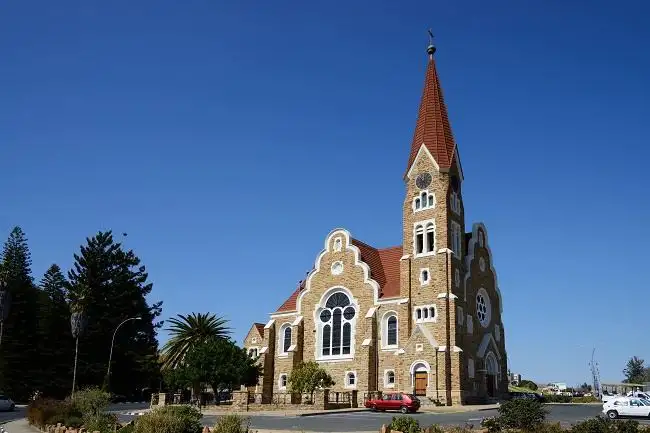
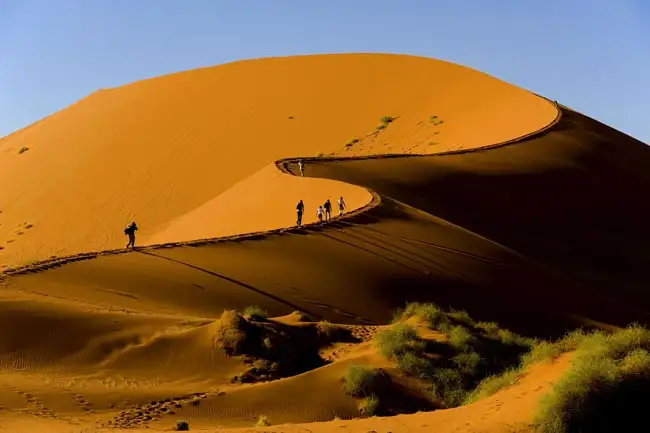
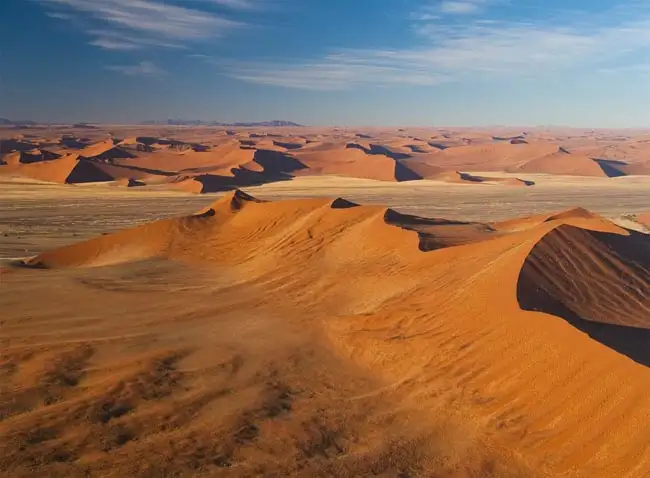
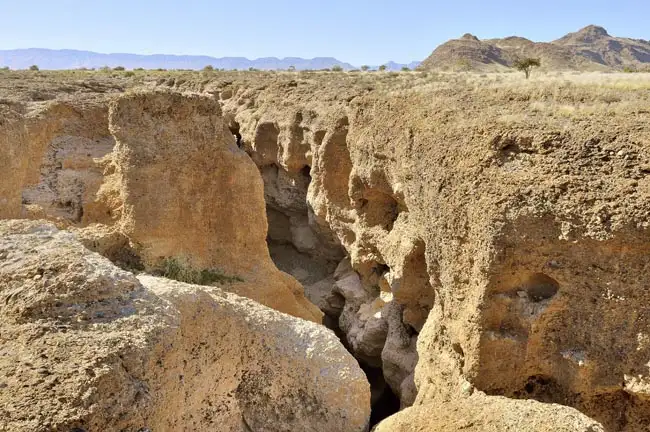
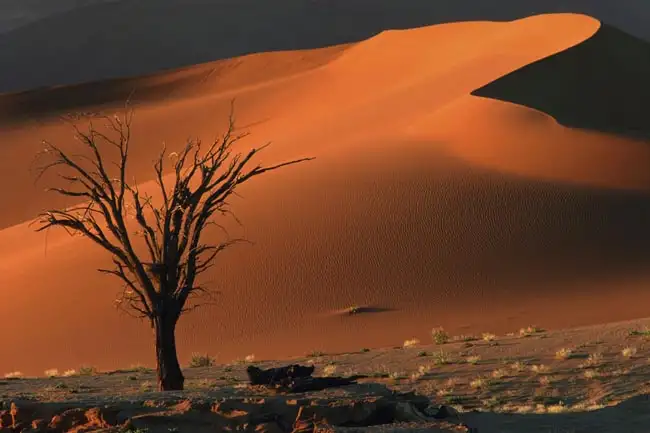
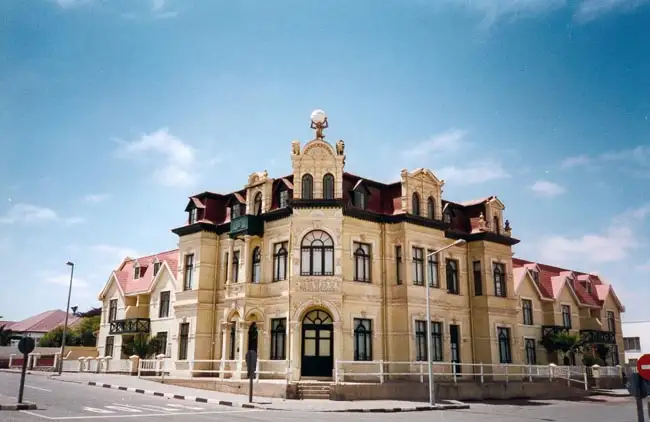
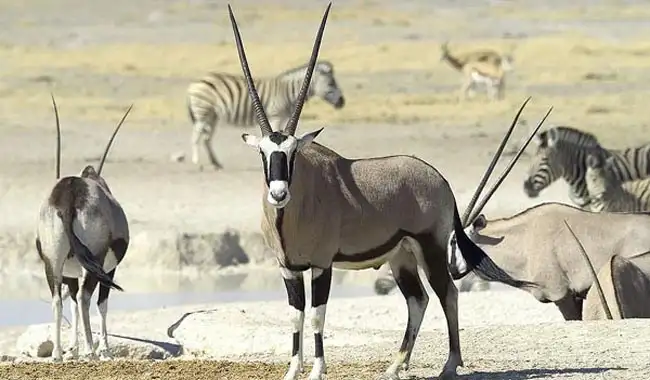
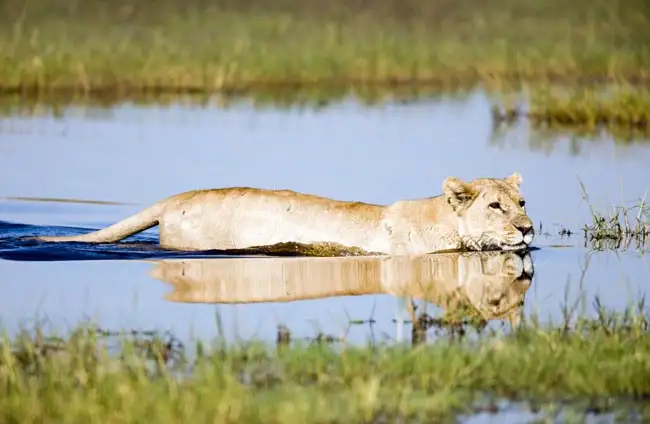
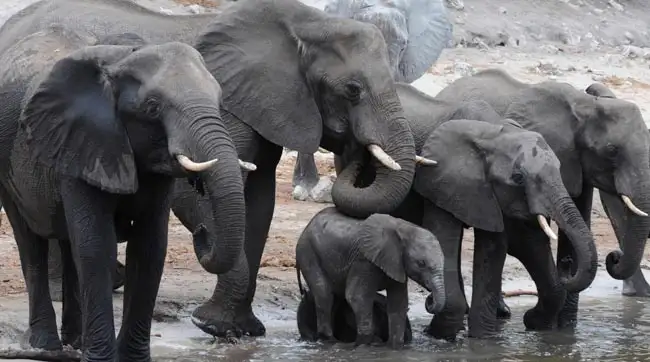
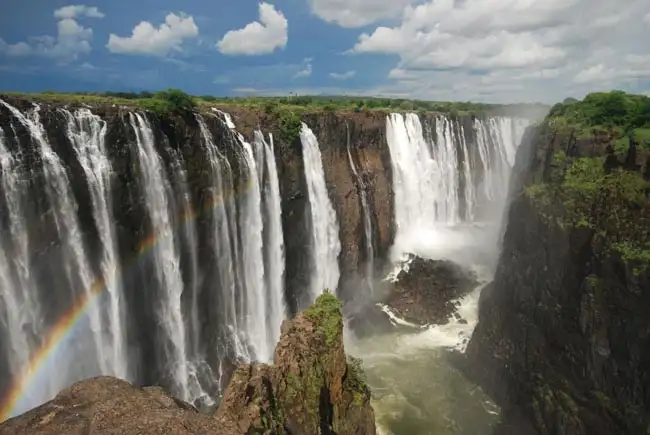
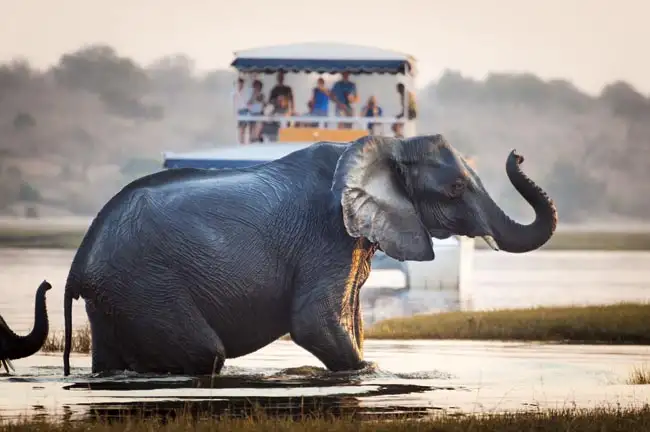
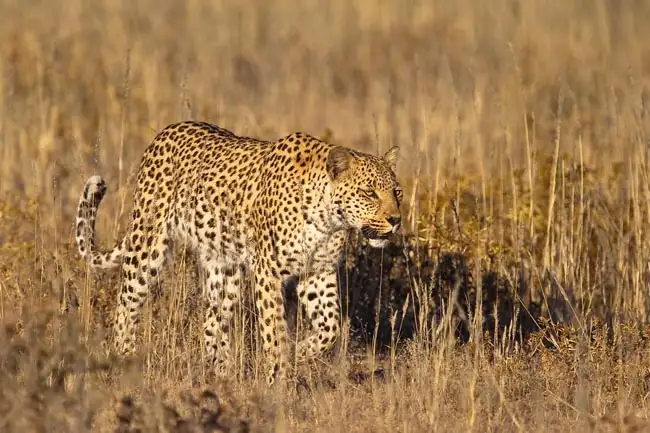
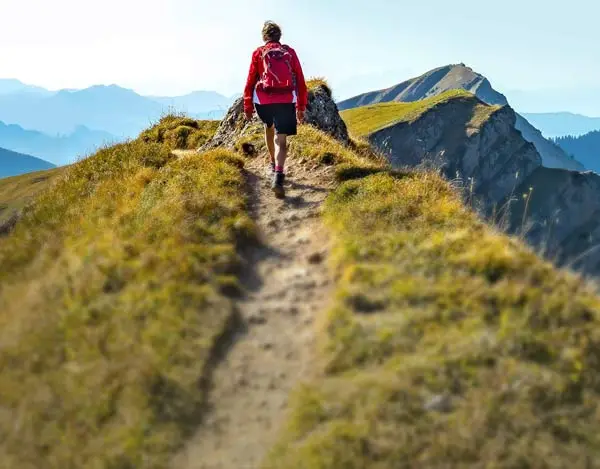
Book This Tour
- Final payment: Due 90 days prior to departure.
- Deposit: A non-refundable $1000 USD Deposit is required at booking.
- Optional Single Supplement: $2450 USD (number of singles limited).
(View options forsingle travellers) - $1000 DEPOSIT REQUIRED due to Botswana accommodation which needs to be paid in full well in advance. Once our tour becomes 'guaranteed,' we will require an additional non-refundable pre-payment of $1500 per person at which point your initial deposit and extra payment become 100% non-refundable/non-transferrable.
Prices below are per person, twin-sharing costs in US Dollars (USD). Pricing does not include airfare to/from the tour and any applicable taxes.
Frequently Asked Questions
- What is the maximum number of participants on a trip?Most of our tours carry a maximum of 18 participants; some tours (ie hiking tours) top out at 16. In the event that we do not achieve our minimum complement by our 90-day deadline, we may offer group members the option of paying a "small-group surcharge" as an alternative to cancellation. If all group members agree, we will confirm the trip at existing numbers; this surcharge is refundable in the event that we ultimately achieve our regular minimum. If the small group surcharge is not accepted, we will offer a refund of your deposit or a different trip of your choice.
- Can I extend my tour either at the beginning or end? What about stopovers?Yes, you can extend your tour either at the beginning or the end and we can book accommodation in our tour hotel. Stopovers are often permitted, depending on air routing. Stopovers usually carry a "stopover" fee levied by the airline.
- How do I make a reservation? How and when do I pay?The easiest way to make a reservation is via our website; during office hours, you are also more than welcome to contact us by telephone.
A non-refundable deposit is payable at the time of booking; if a reservation is made within 90 days, full payment is required. Some trips require a larger deposit. If international airline bookings require a non-refundable payment in order to secure space or the lowest available fare, we will require an increase in deposit equal to the cost of the ticket(s).
Early enrolment is always encouraged as group size is limited and some trips require greater preparation time.
Once we have received your deposit, we will confirm your space and send you a confirmation package containing your trip itinerary, any visa/travel permit related documents, invoice, clothing and equipment recommendations, general information on your destination(s), and forms for you to complete, sign and return to us. Your air e-tickets (if applicable), final hotel list, final trip itinerary, and instructions on how to join your tour, will be sent approximately 2-3 weeks prior to departure. - What about cancellations, refunds, and transfers?Please review our cancellation policy page for details.
- I am a single who prefers my own room. What is a single supplement?All of our tours have a single supplement for those who want to be guaranteed their own room at each location.
This supplement is a reflection of the fact that most hotels around the world do not discount the regular twin-share rate for a room by 50% for only one person occupying a room. Most hotels will give a break on the price, but usually in the range of 25-30% of the twin-share rate. This difference, multiplied by each night, amounts to the single supplement.
The conventional amount can also vary from country to country and some destinations are more expensive than others for single occupancy. In order to be "single friendly," the supplements we apply are not a profit centre for us and we do our best to keep them as reasonable as possible.
On most tours we limit the number of singles available, not to be punitive, but rather because many hotels allow for only a limited number of singles; some smaller hotels at remote locations also have a limited number of single rooms available.
Please note that most single rooms around the world are smaller than twin-share rooms and will likely have only one bed. - Do you have a shared accommodation program?Yes! If you are single traveller and are willing to share, we will do our best to pair you with a same-gender roommate. Please note that should we fail to pair you, we will absorb the single supplement fee and you will default to a single room at no extra charge.
